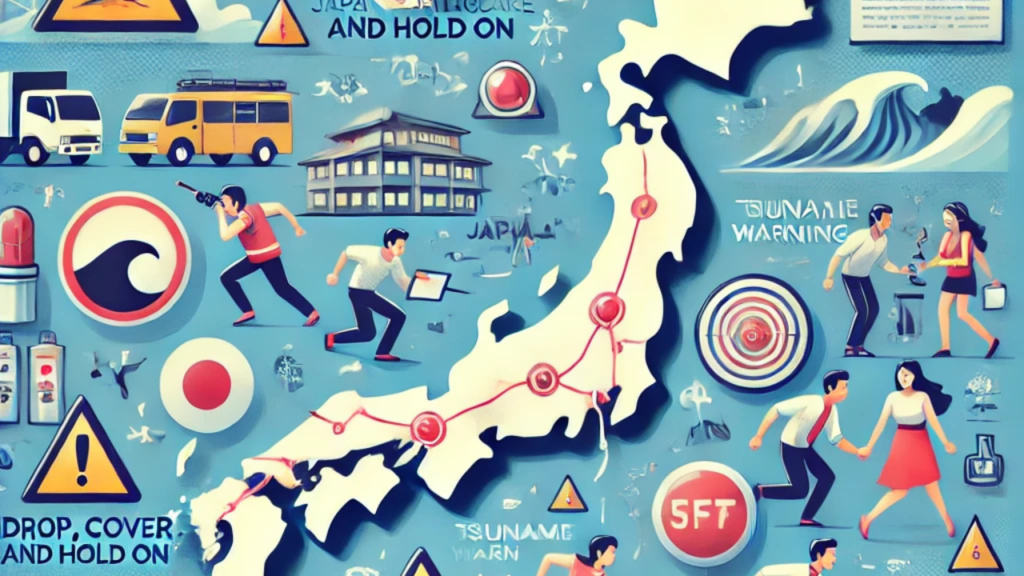Japan Earthquake Tsunami Warning: What to Do in an Emergency

Japan is one of the most seismically active regions in the world, situated along the Pacific Ring of Fire. This geographic reality makes it highly susceptible to earthquakes and tsunamis. The country’s advanced earthquake and tsunami warning systems have saved countless lives, but understanding how to respond during such emergencies is equally crucial. This guide will provide a comprehensive overview of what to do when a Japan Earthquake Tsunami Warning is issued, ensuring safety and preparedness for residents and visitors.
Understanding Japan’s Earthquake and Tsunami Warning System
Japan’s Meteorological Agency (JMA) manages one of the world’s most sophisticated early warning systems. This system uses seismic sensors and ocean buoys to detect earthquakes and predict tsunamis. Alerts are broadcast through multiple channels, including television, radio, mobile apps, sirens, and public announcement systems. These warnings provide crucial seconds to minutes for people to evacuate or prepare for the disaster.
Key Features of the Warning System:
- Real-Time Alerts: Immediate notifications through phones, TV, and public systems.
- Seismic Intensity Measurement: Earthquakes are measured by their intensity (shindo scale) rather than magnitude to determine the impact on people and structures.
- Tsunami Predictions: Wave height, arrival time, and affected areas are provided in the warnings.
What to Do During a Japan Earthquake Tsunami Warning
When a warning is issued, quick and decisive actions can make the difference between life and death. Follow these steps to stay safe:
During the Earthquake
- Drop, Cover, and Hold On: To protect yourself from falling debris, find a sturdy piece of furniture to hide under.
- Stay Indoors Until Shaking Stops: Avoid running outside, as falling glass or debris can cause injuries.
- Move to Open Spaces if Outside: Avoid buildings, trees, and power lines.
Immediately After the Earthquake
- Listen for Tsunami Warnings: Check your mobile alerts, TV, or radio for updates on potential tsunamis.
- Evacuate Quickly if Advised: Move to higher ground or designated evacuation centers immediately if a tsunami warning is issued.
- Avoid Coastal Areas: Avoid beaches, riverbanks, and other low-lying regions.
During the Tsunami Warning
- Follow Evacuation Routes: Japan has marked tsunami evacuation routes in coastal areas. Use these paths to reach higher ground.
- Do Not Delay: Every second counts. Do not waste time collecting belongings.
- Help Vulnerable Individuals: Assist older people, children, and those with disabilities during evacuation.
After the Tsunami
- Stay Informed: Wait for official “all-clear” messages before returning to affected areas.
- Avoid Floodwaters: Tsunami may contain debris, sewage, or hazardous materials.
- Check for Aftershocks: Be prepared for additional earthquakes following the initial one.
Preparedness Tips for Earthquakes and Tsunamis
While immediate actions are critical, preparing beforehand can significantly enhance your safety. Here are some essential preparedness tips:
Create an Emergency Kit
An emergency kit should include:
- Water and non-perishable food for at least three days.
- Flashlight and extra batteries.
- First aid supplies.
- Portable phone charger.
- Essential documents in waterproof bags.
Know Your Evacuation Routes
Familiarize yourself with local evacuation routes and shelters. Maps are often available at community centers or local government offices.
Practice Earthquake Drills
Participate in earthquake drills to understand how to react during a seismic event.
Install Emergency Apps
Download apps like “NHK World” or “Yurekuru Call” to receive real-time earthquake and tsunami alerts.
Secure Your Home
Anchor heavy furniture, install latches on cabinets, and use earthquake-resistant designs if building or renovating your home.
Technological Advancements in Japan’s Warning System
Japan’s technological edge plays a vital role in disaster management. Here are some advancements that enhance the effectiveness of warnings:
- Earthquake Early Warning (EEW): This system can detect seismic waves and issue alerts seconds before shaking begins.
- Oceanic Buoys and GPS: These devices measure changes in sea level to predict tsunamis accurately.
- AI and Machine Learning: Predictive models help assess potential impacts and optimize evacuation plans.
Common Myths About Earthquake and Tsunami Warnings

“I’ll have plenty of time to evacuate.”
Tsunamis can travel up to 500 miles per hour. Evacuation must be immediate.
“Small earthquakes don’t cause tsunamis.”
Even minor seismic activity can trigger underwater landslides that result in tsunamis.
“I’ll be safe in my car.”
Vehicles are not safe during tsunamis. Evacuate on foot to avoid traffic congestion.
“All tsunami waves arrive at the same time.”
Tsunamis consist of multiple waves, often with the largest arriving last.
“The danger is over after the first wave.”
Secondary waves can be equally or more destructive.
The Importance of Community and Global Cooperation
Japan’s expertise in disaster preparedness is a model for other countries. Collaborative efforts between governments, scientists, and local communities enhance resilience against natural disasters. Sharing technology and strategies globally can save more lives.
FAQs About Japan Earthquake Tsunami Warning
What should I do on the coast during a tsunami warning?
Move to higher ground immediately. Follow designated evacuation routes and stay away from beaches and rivers.
How does Japan’s tsunami warning system work?
It uses seismic sensors, GPS buoys, and ocean monitoring systems to detect underwater earthquakes and predict tsunamis.
Can tourists in Japan access tsunami alerts?
Yes, tsunami alerts are broadcast in multiple languages, including English, through apps, TV, and public systems.
What are the most essential items to include in an earthquake emergency kit?
The essential items are water, food, first aid supplies, flashlights, batteries, portable chargers, and important documents.
Are aftershocks dangerous after a tsunami?
Yes, aftershocks can cause additional tsunamis or structural collapses. Stay alert and informed until the danger has passed.
Conclusion
Understanding and acting on a Japan Earthquake Tsunami Warning is critical for survival. You can significantly reduce risks during these natural disasters by staying informed, following official guidelines, and preparing in advance. Whether you’re a resident or a visitor, knowledge, and preparedness are your best defenses against earthquakes and tsunamis.
You May Also Read: https://bestusatime.com/djt-stock-price/



